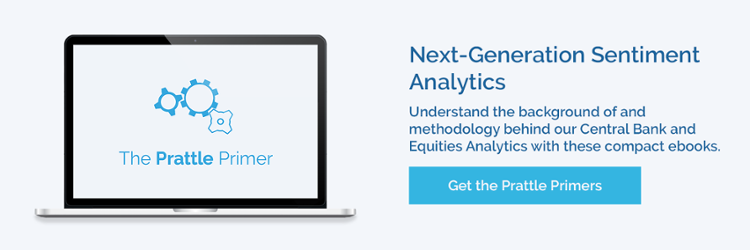Wednesday’s big Bund yield reversal represents another case of algorithmic analysis outperforming market analysts.
Despite his intentions, ECB President Mario Draghi prompted a sharp spike in Bund yields after the market misinterpreted the tone of his remarks at the ECB Forum on Central Banking on Tuesday. Yields collapsed on Wednesday, however, when ECB policymaker Vitor Constancio explained that…
1. …the market had overestimated the hawkishness of Draghi’s language.
2. …the president’s comments were perfectly in keeping with the ECB’s modestly dovish policy stance.
While it took nearly 24 hours for the market to come to its senses, Prattle’s machine learning algorithm accurately evaluated Draghi’s speech in real time. Prattle’s system scored Draghi’s speech as neutral* (0.18) when compared to the average ECB communication and slightly dovish (-0.29) when compared to Draghi’s average tone, which is very close to the ECB’s trend as a whole (momentum** -0.35). In short, this algorithmic assessment falls directly in line with the sentiments of Constancio—but was produced instantly.
Despite what some might think, machines can in fact detect human sentiment, especially as it “translates into future price action.” This week’s events add to the growing body of evidence for the capabilities of financial text analysis technology.
The bottom line: Based on Prattle’s ECB sentiment data, the bank may withdraw stimulus in the medium term but will maintain loose financial conditions for the foreseeable future. Also, if this week is any indication, algorithms seem like they’re gaining more ground on human analysts.
The Prattle Team
*Prattle’s models are based on the historical relationship between central bank language and market reaction, which is used as the basis of evaluation for future communications. The scores are normalized around zero and range between -2 and 2, negative numbers indicating dovishness and positive numbers indicating hawkishness. Aggregate trend is the overall sentiment of the bank calculated using a LOESS fitting of trend using a 12-month window.
**Residual scores represent the tone of a communication compared to the rolling, 12-month average for that individual communication type or speaker. Raw scores represent the tone of a communication compared to the average of all communications. Momentum is the average of the last ten residual scores.


